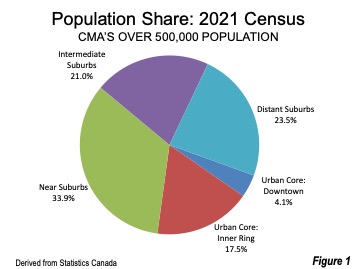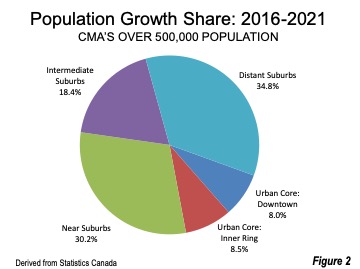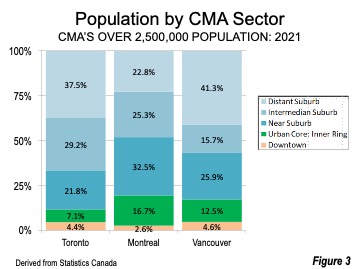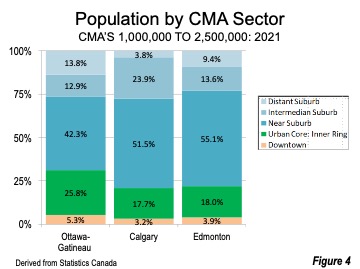
Canada continues to move to the suburbs, as the 2021 census data shows. This is based on a Statistics Canada analysis on metropolitan (Census Metropolitan Areas, or CMAs) population and change since the 2016 Census. Statistics Canada (Statscan) divides the CMA population into five geographic sectors, including downtown, and four other sectors defined by proximity from downtown (in minutes). This urban core/suburbs categorization differs from the core municipality/suburbs approach, with its much more readily available data. The findings are described in “Canada’s large urban centres continue to grow and spread”, which also has a useful array of tables.
Overall according to the 2021 Census, 78.4 percent of the population of the 11 CMAs is in the suburbs, with 21.6 percent in the urban core. The largest population share is in the Near Suburbs (33.9 percent), followed by the Distant Suburbs (23.5 percent) and the Intermediate Suburbs (21.0 percent). The Inner Ring accounts for 17.5 percent of the population, with Downtown having 4.1 percent.
Overall Population and Growth 2016-2021
Overall according to the 2021 Census, 78.4 percent of the population of the 11 CMAs is in the suburbs, with 21.6 percent in the urban core. The largest population share is in the Near Suburbs (33.9 percent), followed by the Distant Suburbs (23.5 percent) and the Intermediate Suburbs (21.0 percent). The Inner Ring accounts for 17.5 percent of the population, with Downtown having 4.1 percent (Figure 1).

Population growth was greater in the suburbs from the 2016 census to 2021. The suburbs captured 83.5 percent of the population growth, 6.5 percent more than its population share of 78.4 percent. The largest gain was in the Distant Suburbs, with a 34.8 percent share, nearly one-half higher than its 2021 share.
Downtowns also grew at a higher percentage rate, adding 8.0 percent, nearly double its 2021 population share of 4.1 percent. Because, however, of its smaller base, Downtown had the smallest numeric population increase among the proximity sectors (Figure 2).

Highlights by CMA
Data for the 11 CMAs with over 500,000 population is summarized by the proximity sectors by population size. CMA’s 2,500,000 & over.
Toronto: In the Toronto CMA, the suburban share of the population is 88.5 percent, while the urban core has 11.5 percent of the population. The largest share lives in the Distant Suburbs (37.5 percent), followed by the Intermediate Suburbs (29.2 percent) and the Near Suburbs (21.8 percent). The smallest share is downtown (4.4 percent), somewhat less than the Inner Ring (7.1 percent). This urban core population share is the smallest among the 11 CMAs. From 2016 to 2021, by far the largest growth was in the Distant Suburbs, which accommodated 73.2 percent of the new population, approximately double its current share of the population. Overall, the suburbs had 83.8 percent of the growth. Downtown had the second strongest growth share, at 13.9 percent. though only 2.3 percent of the growth was in the Urban Core: Inner Ring.
Montreal: The suburban share of the population in the Montreal CMA is 80.7 percent. The largest share is in the Near Suburbs (32.5 percent), followed by the Intermediate Suburbs (25.3 percent) and the Distant Suburbs (22.8 percent). The downtown share was the least (2.2 percent), while the Inner Ring share was much higher (16.7 percent). The largest growth share was also in the Distant Suburbs, though considerably less than in Toronto, at 34.4 percent. Overall the suburbs accounted for 80.7 percent of the population. Montreal’s urban core had more of the growth than its Toronto counterpart, at 19.3 percent, though the distribution was somewhat more balanced (11.4 percent in Downtown and 7.9 percent in the Inner Ring).

Vancouver: The suburban share of the population is 82.9 percent in the Vancouver CMA. The largest share is in the Distant Suburbs (41.1 percent), followed by the Near Suburbs (25.9 percent) and the Intermediate Suburbs (15.7 percent). The downtown share of the population is 4.5 percent, and the Inner Ring has a larger 12.5 percent of the population. Vancouver had the highest share of its growth in the suburbs among the 11 largest CMAs, at 88.6 percent. The Distant Suburbs had by far the largest growth share, at 52.8 percent. The urban core growth share was the lowest among the three largest CMAs, at 11.1 percent. Data for these CMAs is shown in Figure 3, above, and Tables 1 and 2, page 11 of the report.
CMAs 1.0 to 2.5 Million Population
Ottawa-Gatineau: The Ottawa-Gatineau CMA has 68.9 percent of its population in the suburbs, with the largest sectoral share in the Near Suburbs (42.3 percent), The Inner Ring has 25.8 percent of the population. The Intermediate Suburbs and Distant Suburbs have 12.9 percent and 13.8 percent of the population respectively, while downtown has 5.3 percent. Population growth in Ottawa-Gatineau between 2016 to 2021 was 80.1 percent in the suburbs and 19.9 percent in the urban core. The largest growth share was in the Near Suburbs (40.5 percent).
Calgary: The Calgary CMA has 78.8 percent of its population in the suburbs and 21.2 percent in the urban core. The largest population share is 51.5 percent in the Near Suburbs. The Intermediate Suburbs (23.9 percent) and Distant Suburbs (3.8 percent) have somewhat fewer residents. The Inner Ring has 17.7 percent of the population and Downtown has 3.2 percent.
Edmonton: The Edmonton CMA has 78.1 percent of its population in the suburbs and 55.1 percent in the Near Suburbs, with 13.6 percent in the Intermediate Suburbs and 9.4 percent in the Distant Suburbs. The Inner Ring has 17.7 percent of the population and Downtown has 3.2 percent.

Between 2016 and 2021, Edmonton alone suffered a population loss in the urban core (a minus 5.3 share). The suburbs had 105.3 percent of the CMA growth.
Data for these CMAs is shown in Figure 4 and Tables 1 & 2 of the report.
Read the entire Backgrounder at Frontier Centre for Public Policy.
Wendell Cox is principal of Demographia, an international public policy firm located in the St. Louis metropolitan area. He is a founding senior fellow at the Urban Reform Institute, Houston, a Senior Fellow with the Frontier Centre for Public Policy in Winnipeg and a member of the Advisory Board of the Center for Demographics and Policy at Chapman University in Orange, California. He has served as a visiting professor at the Conservatoire National des Arts et Metiers in Paris. His principal interests are economics, poverty alleviation, demographics, urban policy and transport. He is co-author of the annual Demographia International Housing Affordability Survey and author of Demographia World Urban Areas.
Mayor Tom Bradley appointed him to three terms on the Los Angeles County Transportation Commission (1977-1985) and Speaker of the House Newt Gingrich appointed him to the Amtrak Reform Council, to complete the unexpired term of New Jersey Governor Christine Todd Whitman (1999-2002). He is author of War on the Dream: How Anti-Sprawl Policy Threatens the Quality of Life and Toward More Prosperous Cities: A Framing Essay on Urban Areas, Transport, Planning and the Dimensions of Sustainability.
Photo: Toronto Suburbs: 73% of 2016-2021 growth was in the “distant suburbs.” (by author).












